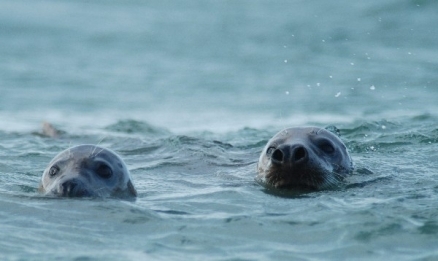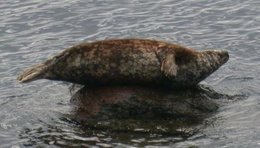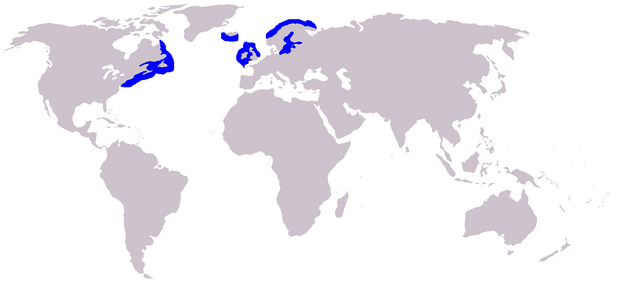Grey seal
The Grey seal (Halichoerus grypus), is one of 19 species of marine mammals in the family of true seals. Together with the families of eared seals and Walruses, True seals form the group of marine mammals known as pinnipeds. This medium sized seal displays adult sexual dimorphism, and can engage in forays of underwater foraging covering considerable swimming distances. This seal, like many other of its genera, participates in notable parasitic life cycles that involve numerous fish species.
There are two subspecies recognized
| Conservation Status |
|
Scientific Classification Kingdom: Animalia (Animals) |
| Common Names: Atlantic gray seal Atlantic seal Baltic gray seal Grey seal Horsehead Seal Gray seal Horsehead |
- Halichoerus grypus grypus (Fabricius, 1791). Western Atlantic gray seal
- Halichoerus grypus macrorhynchus Hornschuh and Schilling, 1851. Eastern Atlantic gray seal
Contents
Physical Description
The coat colour varies from grey to brown to silver, often with blotches.The female Grey seal is silver-grey in colour, with small scattered dark spots, while the males are a dark grey with silver grey spots.
At birth, pups weigh approximately 16 kg and have long, creamy white fur which is shed after the first three weeks of life. They fatten quickly on the rich milk from their mothers, and by moulting age have nearly quadrupled in body mass. At this time the young seals show coat patterns which differentiate the sexes.
In addition to coat markings, the nose of a Grey seal can distinguish male from a female. The male Grey seal has a long-arched roman nose which is the basis for its Latin name, Halichoerus grypus, meaning the hooked-nose sea pig.
The shoulders of the male are massive with the overall bulk supplemented by a buildup of scar tissue from fighting during breeding seasons. The average adult male reaches his maximum size of 2.2 meters long and 220 kg at 11 years of age. The female is smaller and does not attain full size until approximately 15 years of age, reaching an average weight of 150 kg and length of 1.8 meters (measured from nose to tail). She has a more narrow, short nose and a straight profile to the dorsal surface of the head.
Distinguishing characteristics for field identification are that the Grey seal is a medium size seal, with elongated head ("horsehead"), W-shaped nostrils; moreover, the coat is mottled, females having light coat with dark spots and males having dark coat with light spots. When the fur is wet it appears grey or dark..
Distribution and habitat
There are two subspecies, with differing geographic distributions:
- Atlantic grey seal (Halichoerus grypus grypus): Western and eastern North Atlantic Ocean
- Baltic grey seal (Halichoerus grypus macrorhynchus): Baltic Sea
Formerly the western and eastern Atlantic population were viewed as distinct subspecies, but are now considered taxonomically euivalent. The western Atlantic population occurs off the coast of Canada stretching from north Labrador south to New England, and rarely as far south as Virginia. The eastern Atlantic population occurs along the coasts of the United Kingdom and Ireland, and on the perimeter of the Faroe Islands, Iceland, Norway, and northwestern Russia as far as the White Sea. Smaller populations occur along the French, Dutch, and German coastal zones, and errant Grey seals have been found as far south as Portugal.(Seal Conservation Society)
The habitat of the Grey seal differs among each individual group of seals. Some are found along rocky continental coasts, while others are comfortable on isolated islands. There are also many Grey seal populations around that haul out on icebergs and ice shelves. They are frequently found in sheltered esturaries with shallow submerged or exposed rocks used for resting and drying out.
Reproduction and lifespan
During the months prior to the breeding season, seals actively feed. The females do so to grow for the future developing fetus and to build the fat reserves which will sustain them and the calf for the fasting period which follows the birth, usually lasting for three weeks. The males also actively feed, because they too will fast for the breeding season; however, their fasting will typically last for up to six weeks.
The males ordinarily enter the rookeries once the females give birth and try to gain sole access to groups of females. Territory-related fighting occurs during the breeding season, although it is relatively minor compared to other seal species. Fighting in Grey seal communities differs among populations, but generally increases as does the density of females. The successful males are able to mate with up to ten females, depending upon locality and density of the females.
Sixteen percent of female Grey seals are sexually mature on their third birthday and give birth to their first young one year later. This figure rises to seventy-one percent by the fourth year and eighty-nine percent by the fifth year of life. The males also become sexually mature at age three, but due to competition for females, rarely mate before they are eight years old.
Once impregnated and following a gestation period of eleven months, females usually give birth a day after coming ashore at the rookery. Grey seals are attentive mothers and defend their pups against predation and intrusion. The pup is nursed for approximately 2 weeks after it is born, gaining around 1.5 kg per day. Once the pup is weaned, the female mates with one or more males and then leaves the pup at the rookery. The pup will remain on land, living off of its blubber reserves until it has fully molted, at which point it will feed at sea. The young seals generally disperse in many different directions from the rookery and are known to wander to distances of over 1000 km.
The species lifespan ranges from 15 to 25 years, with the oldest recorded wild female Grey seal living to be 46 years of age.
Parasitic ecology
Both parasitic and bacterial attacks may occur to the Grey seal; either circumstance may weaken the individual and may be a cause for stranding on land, sometimes with resulting death. In a number of locations humans carry out rescue efforts to foster such weakened animals, when it is clear that the seal is likely to die without intervention. An example parasite which the Grey seal may host is a roundworm known as codworm (Pseudoterranova decipiens), a species that infects cod and certain other commercially harvested fish. This parasite in its larval stage typically resides in musculature or body cavities of juvenile cod and other benthophagous fishes. The Grey seal may also acquire this parasite by eating sculpins, who in tern have consumed cod.
Studies at Sable Island in Nova Scotia and other locations imply that the breeding season can be an important time for spread of the codworm parasite. It is thought that pups lack resistance to this parasite, and their concentrations in breeding areas are correlated with incidence of marine transmission to certain fisheries. For example several thousand pups may be born at Sable Island annually and the subsequent incidence of cod worm is correlated temporally with dispersal patterns of the pups, with the seal breeding grounds at the epicenter. (Anderson, 2000)
Feeding Habits
Grey seals forage underwater and spend the remainder of their time on the coastlines. They are non-migratory creatures yet disperse widely after breeding season. Grey Seals are opportunistic feeder consuming between four and six percent of its body weight in one feeding per day. The diet consists of a large variety of fish and the occasional crustaceans and mollusks. According to King, at least 29 different species of fish have been recorded as being eaten by these seals. Fish taken include nearly any species found at pelagic and midwater levels as well as bottom dwelling fish at depths of seventy or more meters.
The feeding methods of the grey seal vary among populations, however they are most often social feeders. Social feeding reduces the opportunity for the prey to escape thereby increasing the feeding efficiency. When small fish are caught by the seal, they are usually consumed underwater and are swallowed whole. However, when large fish are captured, they are brought to the surface and held in the prehensile front flippers. The fish head is then bitten off and discarded, while the remainder of the fish is broken into small pieces able to be swallowed.
Conservation Status
The Grey seal species as a whole is considered a species of Least Concern. (IUCN) In fact, many countries allow either monitored or unlimited hunting of the seals. For nearly a decade, from 1982 until 1993, Norway, Iceland and Canada offered bounties and local culls for the Grey seal. Many fisherman believe that this species competes with them for fish, and seals damage nets and traps. Recently the species has been given great legal protection in Europe, and fewer culls are being authorised.
The Baltic Sea population (estimated at 22,000 in 2007) of this species is much smaller than the two Atlantic population. Due to historic hunting and habitat pollution. this subspecies has greater legal protection.
In 1914 the United Kingdom Grey seal population was thought to number only 500, and the Grey Seals Protection Act was introduced that year. The Sea Mammal Research unit estimated that the British grey seal population numbered 124,300 in the year 2000, representing 40% of the world population. The population is increasing, which has led to controversial concerns by fishermen that they pose a threat to fish stocks. Although protected between 1 September and 31st December by the Conservation of Seals Act] (1970), they can still legally be shot during this time if they are damaging fishnets, furthermore illegal shooting continues. Grey seals are sensitive to disturbance by people and dogs, particularly when lactating. They are also susceptible to oil and chemical pollution and often become tangled up in fishing nets, which may be fatal.
Protected in Europe under Annex II and V of the EC Habitats Directive, and Appendix III of the Bern Convention. In Britain it is protected under the Conservation of Seals Act 1970 (closed season 1 September-31st December), and listed under Schedule 3 of the Conservation Regulations (1994).
Several important grey seal sites in EC member countries have been proposed as Special Areas of Conservation. In August 1999 the location of the world's third largest island-based grey seal breeding colony, the uninhabited island of Ling Holm in the Orkney Islands was purchased by the Scottish Wildlife Trust as a sanctuary for grey seals. It has been suggested that human access to breeding sites could be restricted. This has occurred at Berry Head in Devon, where video monitors have been used to show the breeding seals to visitors, so pressures on the breeding site are reduced.
Relationship to Humans
In the past, Grey seal pups were killed and harvested on a large commercial scale for their skins, although there have been no recent large-scale hunts. Grey seals are believed by some commercial fisherman to be a pest. They may remove fish from nets, become tangled in nets, damage traps, and feed on farmed fish. By hosting the codworm (P. decipiens), that infects cod and other commercially harvested fish, the Grey seal is also blamed for transmitting this parasite to certain fisheries.There is some dispute about the existence of large-scale impacts of Grey seals on the Atlantic fisheries, but this seal species can be occasionally a problem for commercial fishing in localised situations.
Many people have an enhanced coastal outing experience by observing the Grey seal and its antics during haul-out and sunning. This pastime can be particularly rewarding during the breeding season, when terrestrial and near-shore viewing opportunities are plentiful.
References
- Halichoerus grypus (Fabricius, 1791) Encyclopedia of Life (accessed December 25, 2009)
- Halichoerus grypus, Smith, J., 2008, Animal Diversity Web (accessed December 25, 2009)
- Grey Seal: Halichoerus grypus, Seal Conservation Society (accessed December 25, 2009)
- Halichoerus grypus, IUCN Red List of Threatened Species (accessed December 25, 2009)
- The Pinnipeds: Seals, Sea Lions, and Walruses, Marianne Riedman, University of California Press, 1991 ISBN: 0520064984
- Encyclopedia of Marine Mammals, Bernd Wursig, Academic Press, 2002 ISBN: 0125513402
- Marine Mammal Research: Conservation beyond Crisis, edited by John E. Reynolds III, William F. Perrin, Randall R. Reeves, Suzanne Montgomery and Timothy J. Ragen, Johns Hopkins University Press, 2005 ISBN: 0801882559
- Walker's Mammals of the World, Ronald M. Nowak, Johns Hopkins University Press, 1999 ISBN: 0801857899
- Grey Seal, MarineBio.org (accessed April 14, 2009)
- Stienen, E.W.M.; Van Waeyenberge, J.; Kuijken, E. (2003). Zeezoogdieren in Belgisch mariene wateren (Marine mammals in Belgian marine waters). Rapport Instituut voor Natuurbehoud, A.2003.152. Instituut voor Natuurbehoud: Brussel, Belgium. 15 pp.
- Hewer, H. 1974. British Seals. London: Collins. ISBN: 0002130327
- Hickling, G. 1962. Grey Seals and the Farne Islands. London: Routledge and Kegan Paul. ASIN: B0000CLAU6
- King, J. 1983. Seals of the World. Ithaca, New York: Comstock Publishing Associates. ISBN: 0801499534
- Zakharov, V., A. Yablokov. 1990. Skull Asymmetry in the Baltic Grey Seal: Effects of Environmental Pollution. Ambio, 19: 266-269.
- Anderson, R.C. 2000. Nematode parasites of vertebrates: their development and transmission, CAB International, 672 pages ISBN: 0851994210



